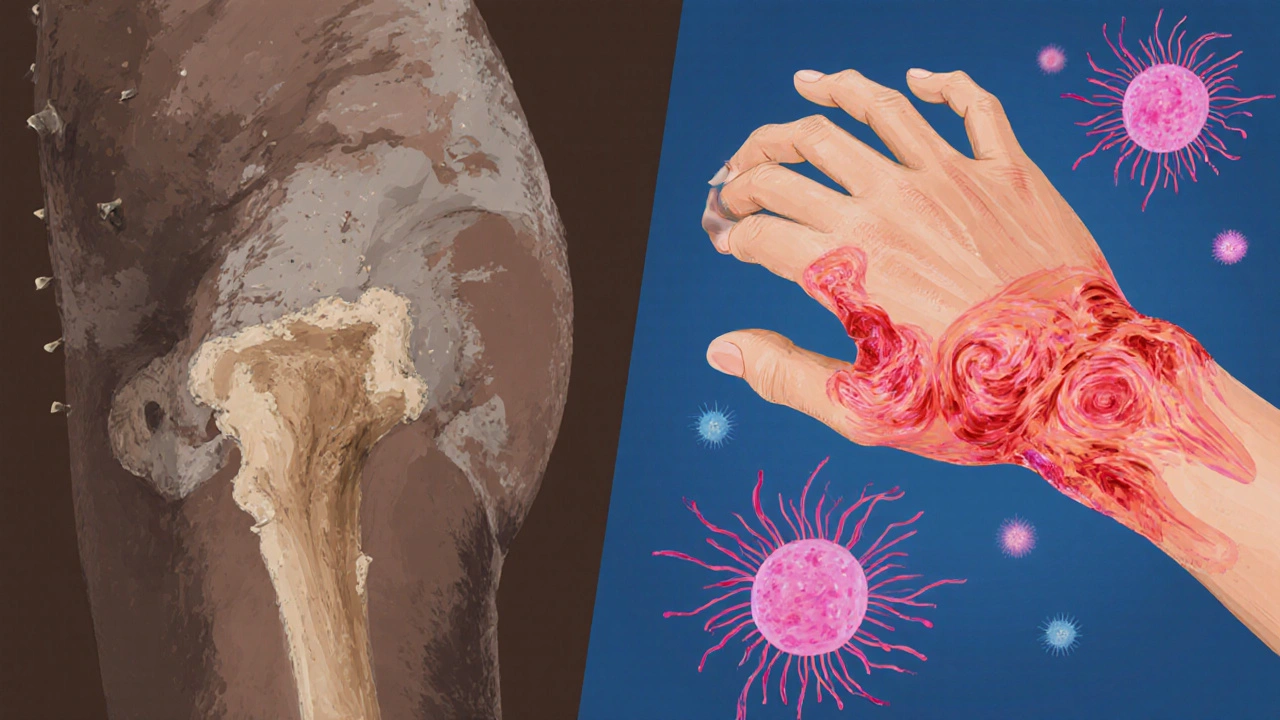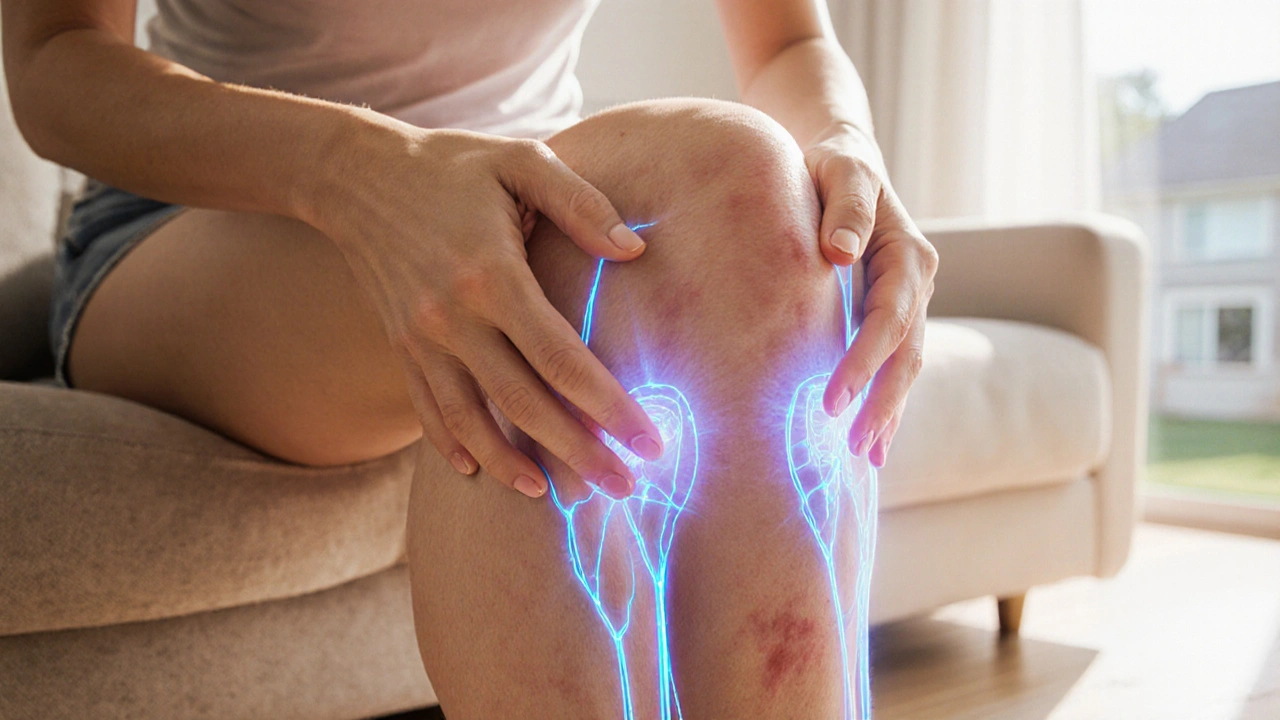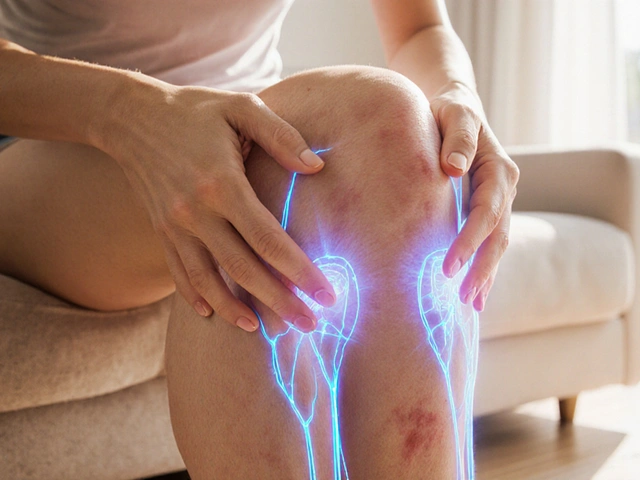Arthritis Risk Assessment Calculator
Personal Information
Risk Factors
Your Risk Level
Feeling a sharp or dull ache every time you climb stairs or reach for a coffee mug? You’re not alone. Millions of people wake up with arthritis-related discomfort, yet many mistake regular joint soreness for a simple sprain. This guide clears the fog: it explains how joint pain ties into arthritis, when the pain signals something deeper, and what steps you can take right now.
Quick Takeaways
- Joint pain can be a warning sign of arthritis, but not every ache means you have the disease.
- Osteoarthritis stems from wear‑and‑tear, while rheumatoid arthritis is an autoimmune attack on joint tissue.
- Key risk factors include age, genetics, previous injuries, and excess weight.
- Early diagnosis combines physical exams, imaging, and blood tests.
- Managing symptoms often blends lifestyle tweaks, physiotherapy, medication, and targeted supplements.
What Is Arthritis?
Arthritis is a broad term for inflammation of one or more joints, leading to pain, stiffness, swelling, and reduced mobility. The condition isn’t a single disease; it’s an umbrella covering over a hundred different types, each with its own triggers and progression patterns. Understanding the general definition helps you spot red flags before they turn into chronic limitations.
Joint Pain: Symptom, Not Diagnosis
When you first feel discomfort, your body is sending a signal that something isn’t right. Joint pain is the most common symptom of arthritis, but it also appears in injuries, infections, and even metabolic disorders.
The difference lies in duration and accompanying signs. A sudden twinge after a fall usually fades as the tissue heals. Persistent ache lasting weeks, especially when paired with swelling or morning stiffness, deserves a closer look. Ignoring such patterns often delays treatment and makes joint damage harder to reverse.
Two Major Players: Osteoarthritis vs. Rheumatoid Arthritis
While dozens of arthritis forms exist, two dominate the conversation because they affect the majority of patients.
| Aspect | Osteoarthritis (OA) | Rheumatoid Arthritis (RA) |
|---|---|---|
| Cause | Degeneration of cartilage from wear and tear | Autoimmune attack on the synovial lining |
| Typical Age of Onset | 40‑60 years | 30‑50 years, often earlier in women |
| Joint Pattern | Usually isolated joints (knees, hips, hands) | Symmetrical involvement (both hands, wrists) |
| Inflammation | Low‑grade, occasional swelling | High, persistent swelling and warmth |
| Treatment Focus | Weight management, joint protection, NSAIDs | Disease‑modifying drugs, biologics, aggressive physiotherapy |
Understanding these distinctions helps you communicate effectively with your healthcare provider and choose the right management plan.
Why Does Joint Pain Turn Into Arthritis?
Several mechanisms can push a simple ache into full‑blown arthritis:
- Cartilage breakdown: Repeated stress erodes the smooth surface that cushions bones, exposing raw tissue.
- Inflammation cascade: Damaged cartilage releases chemicals that inflame the synovial fluid, swelling the joint capsule.
- Joint instability: As the joint loses its protective layers, bones may rub directly, creating pain spikes.
Not every joint pain follows this path. People with healthy lifestyles, appropriate weight, and regular movement often keep cartilage intact despite years of activity.

Key Risk Factors
Some elements you can control, others you can’t. Knowing the difference empowers you to act where possible.
- Age: Tissue elasticity declines, making cartilage more vulnerable.
- Genetics: Family history of rheumatoid arthritis raises your odds by up to 30%.
- Previous injuries: A torn meniscus or fractured ankle can seed early osteoarthritis.
- Obesity: Extra pounds add pressure to weight‑bearing joints, accelerating wear.
- Occupation: Jobs demanding repetitive motions (carpentry, assembly line) increase joint stress.
Recognizing the Full Symptom Spectrum
While pain steals the spotlight, arthritis often brings a handful of companion signs. Spotting them early can shave years off the disease’s progression.
- Morning stiffness lasting longer than 30 minutes.
- Visible swelling or a feeling of warmth around the joint.
- Reduced range of motion-trouble bending a finger or squatting fully.
- Joint clicking or grinding noises (crepitus).
- General fatigue, especially in rheumatoid arthritis.
How Doctors Diagnose Arthritis
Diagnosis isn’t a one‑step test; it’s a puzzle assembled from several pieces.
- Medical History & Physical Exam: Your doctor will ask about pain patterns, family history, and lifestyle.
- Imaging: X‑rays reveal cartilage loss and bone spurs; MRI shows soft‑tissue inflammation.
- Laboratory Tests: Blood work checks for rheumatoid factor, anti‑CCP antibodies, and markers of inflammation (CRP, ESR).
- Joint Fluid Analysis: Extracted synovial fluid can rule out gout or infection.
Early detection, especially with rheumatoid arthritis, allows doctors to start disease‑modifying therapy before irreversible joint damage sets in.
Managing Pain and Slowing Progression
Effective arthritis care blends multiple strategies. Below are the most evidence‑backed approaches.
- Weight Management: Shedding 5‑10% body weight can reduce knee joint load by up to 50%.
- Targeted Exercise: Low‑impact activities (swimming, cycling) keep muscles strong without over‑loading joints.
- Physiotherapy: Certified physiotherapy programs teach proper movement patterns, improve flexibility, and reduce pain spikes.
- Medications: NSAIDs for short‑term relief; DMARDs (disease‑modifying antirheumatic drugs) for rheumatoid arthritis; occasional corticosteroid injections for flare‑ups.
- Supplements: Glucosamine, chondroitin, and omega‑3 fatty acids have modest benefits for cartilage health.
- Assistive Devices: Braces, orthotic shoes, and ergonomic tools offload stress from vulnerable joints.
Every plan should be personalized. What works for a 55‑year‑old marathoner differs from a desk‑bound office worker.
When to Seek Professional Help
If you notice any of the following, schedule a check‑up promptly:
- Pain persisting beyond two weeks without improvement.
- Morning stiffness lasting longer than 30 minutes.
- Visible swelling, redness, or warmth.
- Difficulty performing daily tasks (e.g., buttoning a shirt).
- Unexplained weight loss or fever accompanying joint symptoms.
Early intervention often means fewer medications and a quicker return to normal activities.
Living Well with Arthritis
Having arthritis isn’t a life sentence. Many people thrive by embracing a proactive mindset.
- Track symptoms in a journal to spot triggers.
- Stay social - community exercise groups boost motivation.
- Prioritize sleep; restorative rest reduces systemic inflammation.
- Consider counseling if chronic pain affects mood.
Remember, the goal isn’t to eliminate every ache but to keep pain within a manageable range so life remains enjoyable.

Frequently Asked Questions
Can joint pain be caused by something other than arthritis?
Yes. Tendinitis, bursitis, gout, cartilage injuries, and even vitamin D deficiency can produce joint pain. Distinguishing features include the pain’s location, duration, and accompanying symptoms like swelling or fever.
Is there a cure for rheumatoid arthritis?
Currently there’s no cure, but disease‑modifying drugs can put the disease into long‑term remission, halting joint damage and allowing most patients to lead active lives.
How often should I see my doctor for osteoarthritis monitoring?
Most clinicians recommend a check‑up every 6‑12 months, or sooner if you notice sudden pain spikes, new swelling, or difficulty moving the affected joint.
Do supplements really help protect joints?
Evidence is mixed. Glucosamine and chondroitin may provide modest relief for some, while omega‑3 fatty acids consistently reduce overall inflammation. Always discuss supplement use with your healthcare provider.
What lifestyle changes have the biggest impact?
Losing excess weight, staying active with low‑impact exercise, and avoiding prolonged joint immobilization rank highest. Pair these with a balanced diet rich in antioxidants for the best joint‑health boost.





Roberta Giaimo
September 30, 2025 at 14:06Thank you for compiling these key facts about arthritis; the information is clear and well‑structured, which makes it easy to understand the risk factors and management strategies :)
Tom Druyts
October 5, 2025 at 09:44Wow, this is super helpful! I’m feeling motivated to get my numbers in the calculator and see where I stand. Let’s stay proactive and keep those joints moving!
Julia C
October 10, 2025 at 05:22Oh great, another “simple” tool that pretends to predict something as complex as arthritis. As if the government isn’t already tracking every biomarker we have. The hidden agenda is obvious.
John Blas
October 15, 2025 at 01:00Honestly, I’m not impressed. The calculator looks shiny, but I doubt it captures the real drama of joint pain in everyday life.
Darin Borisov
October 19, 2025 at 20:38Whilst perusing the aforementioned exposition concerning arthritic pathophysiology, one is inevitably confronted with a panoply of epidemiological determinants that, when synthesized, constitute a veritable tapestry of multifactorial risk assessment. The algorithmic architecture delineated herein purports to operationalize variables such as chronological age, adiposity indices, hereditary predisposition, antecedent musculoskeletal trauma, and occupational biomechanical load. By employing a weighted additive schema, the instrument ostensibly stratifies individuals into discrete probabilistic cohorts, thereby facilitating preemptive clinical interventions. It is incumbent upon the discerning reader to interrogate the statistical underpinnings of the model, notably the calibration of score thresholds and the sensitivity‑specificity balance inherent to its prognostic capacity. Moreover, the conflation of body mass index with adipose tissue distribution warrants nuanced critique, given the heterogeneity of visceral versus subcutaneous fat deposition. The inclusion of familial lineage as a binary variable, while expedient, may obfuscate polygenic susceptibility loci elucidated through contemporary genome‑wide association studies. Similarly, the binary codification of prior joint injury neglects the gradations of severity, chronicity, and rehabilitative outcomes that modulate long‑term joint integrity. Occupational stressors, categorized dichotomously, fail to capture the spectrum of repetitive strain, ergonomic ergonomics, and psychosocial occupational factors that synergistically exacerbate degenerative processes. In sum, while the calculator serves as an accessible entry point for layperson engagement, its heuristic limitations must be acknowledged. Future iterations would benefit from incorporating continuous variables, longitudinal data inputs, and adaptive machine‑learning algorithms to refine predictive accuracy. Such enhancements would align the tool with the exigencies of precision medicine, ultimately augmenting its utility in both preventive orthopaedic practice and patient‑centered health literacy.
Sean Kemmis
October 24, 2025 at 16:17Interesting but overly optimistic.
Nathan Squire
October 29, 2025 at 10:55While the calculator is undeniably user‑friendly, remember that it is a simplification; always consult a rheumatologist for a comprehensive assessment. Also, staying active and maintaining a healthy weight are proven strategies for reducing joint stress.
satish kumar
November 3, 2025 at 06:33Ah, the so‑called “risk calculator”, a marvel of modern web development, replete with dropdown menus, numeric inputs, and a single button that promises to unveil one’s fate regarding arthritic degeneration, an endeavor that, in truth, is fraught with statistical nuance, yet presented in a format so starkly simplistic that it borders on the absurd, don’t you think?
Matthew Marshall
November 8, 2025 at 02:11This is exactly what I needed.
Lexi Benson
November 12, 2025 at 21:49Oh, brilliant-now we can all pretend we’re doctors with a few clicks. 🙄
Vera REA
November 17, 2025 at 17:27Nice overview. The calculator could be a good conversation starter at community health events.
John Moore
November 22, 2025 at 13:06Great info, everyone. Let’s keep the discussion respectful and focus on sharing reliable resources.